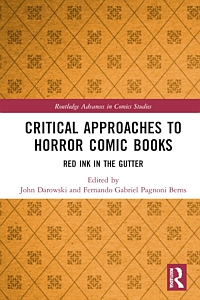For those interested in superhero comics and the many connections to heritage, cultural standing and so forth associated with the category, there is no shortage of academic and popular titles. Fortunately, there are several new studies each year.
 With horror comic books, however, things are different. The horror genre, when approached from the perspective of film studies or – somewhat similar and still close to the horror genre – the “gialli,” is well researched meanwhile. However, the horror comic, apart from the classics such as EC Comics and compilations of popular monster magazines is rather poorly represented.
With horror comic books, however, things are different. The horror genre, when approached from the perspective of film studies or – somewhat similar and still close to the horror genre – the “gialli,” is well researched meanwhile. However, the horror comic, apart from the classics such as EC Comics and compilations of popular monster magazines is rather poorly represented.
Editors John Darowski from the University of Louisville, USA and Fernando Gabriel Pagnoni Berns who teaches at the Universidad de Buenos Aires, Argentina, have collected a number of new thought- provoking texts concerning the genre. And without doubt they have launched a new milepost in horror comic book research.
Luckily the title does not make the mistake of highlighting American comic artists only, but it offers the global perspective instead. The altogether 18 essays of differing length, depth and quality deal with a unique blend of sources from various countries, such as India (City of Sorrows), (France (Zombillénium), Spain (Creepy), Italy (Dylan Dog), and Japan (Tanabe Gou’s Manga Adaptations of H.P. Lovecraft).
It is worth noting that the ideas and artistic comic book expressions of horror, fear, taboos, atrocious actions and so forth on the page diverge strongly in each country and society. At a certain stage after which comic book superheroes, avengers or monsters with origins in the American culture usually were introduced by the publishers in countries far away, after a period of time topics and style started to change, and wholly new characters would appear. As applying or even relocating a specific idea, ghoul, hag-ridden spirit or its manifestation from one social sphere to another is difficult, not to mention to insert the character into the society of another country with entirely different traditions and traditional tales and stories, would not allow certain developments. The essays here and their 17 b/w illustrations tell how unique national horror trends were established.
Naturally, Marvel still receives a lot of space here too, as the publisher decades ago introduced the characters of The Punisher, Man-Thing, Empire of the Dead, and started a cooperation with Attack on Titan. The Punisher’s agenda, for example, over the years was so popular that since the 1970s, the comic has gone through a number of developments and revisions, both on paper, in cinema and then as a TV series and generated two spins-offs.
Obviously, zombies, supernatural spirits, and werewolves also get their share of attention in the research. Not to mention the many emotions and much disillusionment man – some everyday person chosen to become the protagonist on the pages – has to experience to move into diverse states of panic, and the fear of fear itself. In the comics, this happens clandestine, unbeknownst to the protagonists, and it is promoted by propaganda, xenophobia, racism, prejudice and the like that haunt and propel countless horror comic characters. They, in turn, terrorize and even kill perfectly innocent others – that without a single monster, ghoul or vampire in sight in the panel.
This was a major theme, very early on, for example, in the plots of the 1950s EC comics, that portrayed, analyzed and detected fear, especially if used by governments, special agendas of the respective zeitgeist. Indeed, the volume here explains how this genre has “… negotiated with the social and cultural anxieties framing a specific era and geographical space.”
The four parts of Critical Approaches to Horror Comic Books deal with horror comic books on several levels, such as their origins and socio-historical context, race and gender, and their ability to adapt or be modified by other media and the philosophy behind the variety. Not just the ghouls are on the move. “Horror comics are as popular as ever,” according to the editors. But “… their reach into popular culture makes them present as never before. How they will transform to address the ongoing crisis and anxieties only remains to be seen.”
With this selection, it is difficult to name the most promising issue but maybe the chapter on (technical) adaption is the most absorbing read, even though almost all the texts approach the genre from the angle of cultural adaptation. The greatest plus of the book is the strong international focus; a gripping study, not necessarily for comic book fans only.
Review by Dr. A. Ebert © 2023
John Darowski and Fernando Gabriel Pagnoni Berns (eds.) Critical Approaches to Horror Comic Books. Red Ink in the Gutter. (Routledge Advances in Comics Studies) Routledge, 2022, 268 p.
